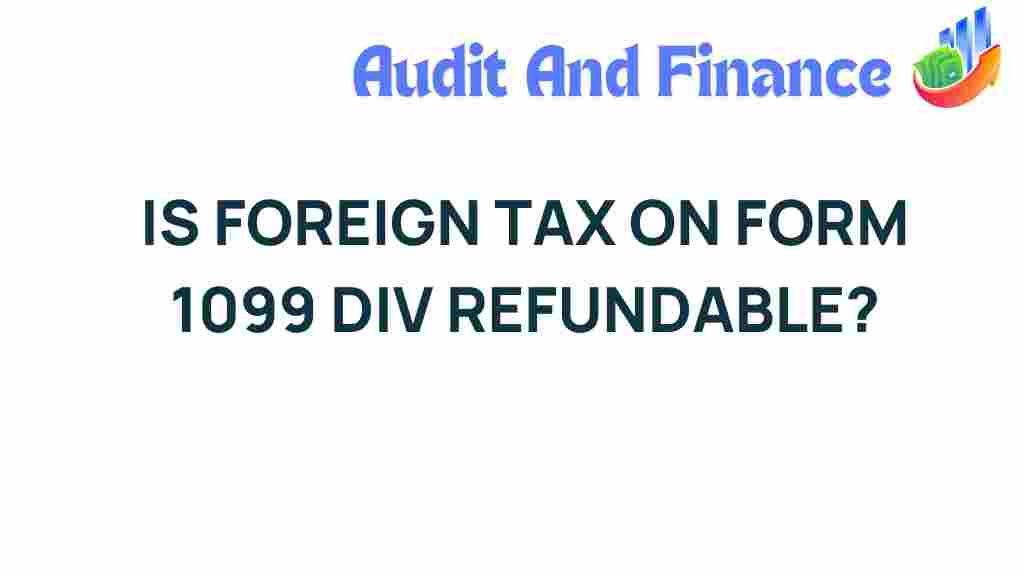Unraveling the Mystery: Is Foreign Tax on Form 1099-DIV Refundable?
When it comes to navigating the complexities of international taxation, understanding the implications of foreign tax withheld on your investment income reported on Form 1099-DIV can be daunting. Many taxpayers wonder whether the foreign tax they paid is refundable. In this comprehensive guide, we will delve into the nuances of foreign tax, Form 1099-DIV, and how it relates to tax refunds, IRS rules, and tax treaties. By the end, you’ll have a clearer understanding of the options available to you.
What is Form 1099-DIV?
Form 1099-DIV is a tax form used to report dividends and distributions received from investments. It is crucial for taxpayers who earn income from stocks, mutual funds, or other investment vehicles. The form details the amount of dividends received, any capital gains distributions, and any foreign tax withheld on those dividends.
Understanding Foreign Tax Withholding
Foreign tax refers to taxes imposed by a foreign country on income earned within its borders. For U.S. taxpayers, this often occurs when dividends are paid by foreign corporations. The foreign government may withhold a percentage of these dividends as tax, which is reported on Form 1099-DIV.
Foreign tax withholding is typically a result of a country’s laws regarding taxation of non-residents. This withholding tax can vary significantly depending on the country and the specific tax treaties in place between the U.S. and that country.
Why is Foreign Tax Refundable?
Whether foreign tax is refundable depends on several factors, including:
- The amount of foreign tax withheld
- Your tax liability in the U.S.
- Applicable tax treaties between the U.S. and the foreign country
In many cases, if you have paid foreign tax on your investment income, you may be eligible for a tax refund or a tax credit. This is primarily to prevent double taxation, where you would pay taxes on the same income in both the foreign country and the U.S.
Step-by-Step Process for Claiming a Refund on Foreign Tax Withheld
To determine if you can claim a refund for foreign tax withheld, follow these steps:
Step 1: Review Your Form 1099-DIV
Start by carefully reviewing your Form 1099-DIV for details on the foreign tax withheld. Look for the box labeled “Foreign Tax Paid” to see how much was deducted from your dividend income.
Step 2: Check for Tax Treaties
Investigate if there is a tax treaty between the U.S. and the foreign country from which you received dividends. Tax treaties often reduce the withholding tax rate on dividends, which might mean you overpaid. You can find a list of tax treaties on the IRS website.
Step 3: Determine Your Eligibility for Foreign Tax Credit or Deduction
As a U.S. taxpayer, you can choose to either claim a foreign tax credit or take a deduction for foreign taxes paid. The foreign tax credit is often more beneficial, as it directly reduces your tax liability.
- Foreign Tax Credit: Form 1116 is used to claim this credit. It is limited to the amount of U.S. tax attributable to your foreign income.
- Foreign Tax Deduction: Alternatively, you can choose to deduct the foreign tax paid as an itemized deduction on Schedule A of your tax return.
Step 4: Complete Your Tax Return
When filing your tax return, ensure you include any Form 1116 or the relevant deductions. The IRS rules require accurate reporting of foreign income and taxes paid, so be diligent in your reporting.
Step 5: Keep Records
Maintain detailed records of your investments, any foreign tax withheld, and your completed tax forms. This documentation will be essential if the IRS requests further information.
Troubleshooting Common Issues with Foreign Tax Refund Claims
Even with a solid understanding of the process, you may encounter challenges when claiming a refund for foreign tax withheld. Here are some common issues and how to address them:
Issue 1: Incorrect Reporting on Form 1099-DIV
If the foreign tax reported on your Form 1099-DIV seems incorrect, contact the financial institution that issued the form. They may need to provide an amended form if errors are found.
Issue 2: Missing Tax Treaties
Sometimes, taxpayers are unaware of tax treaties that may apply. Research thoroughly or consult a tax professional to ensure you are not missing out on potential benefits.
Issue 3: Complexity of IRS Rules
The IRS rules regarding foreign tax credits and deductions can be intricate. If you are unsure about how to proceed, consider seeking assistance from a tax advisor who specializes in international taxation.
Conclusion: Navigating the Refund Process
In conclusion, determining whether foreign tax on Form 1099-DIV is refundable involves understanding the nuances of international taxation, IRS rules, and the specific tax treaty arrangements in place. By following the outlined steps, reviewing your documentation, and potentially seeking professional guidance, you can effectively navigate the complexities of claiming a refund for foreign taxes withheld on your investment income.
Being informed about your options is crucial. If you have further questions or need more information, feel free to explore related resources or consult with a tax professional.
For more details about tax treaties and how they impact your investment income, visit the IRS resources page.
This article is in the category Taxation and created by AuditAndFinance Team
